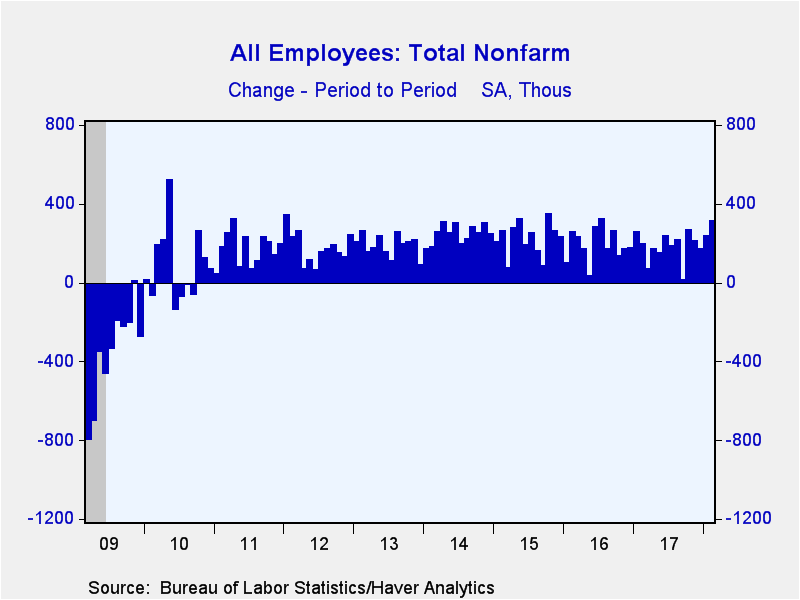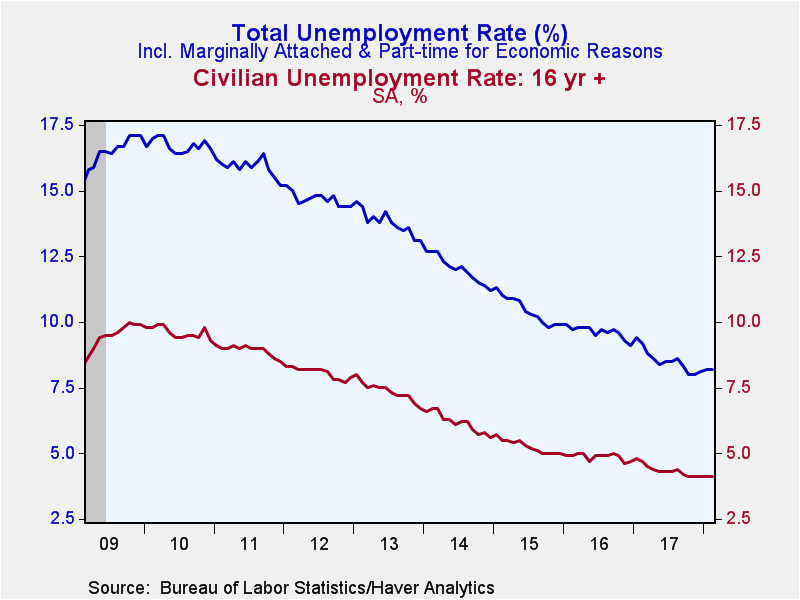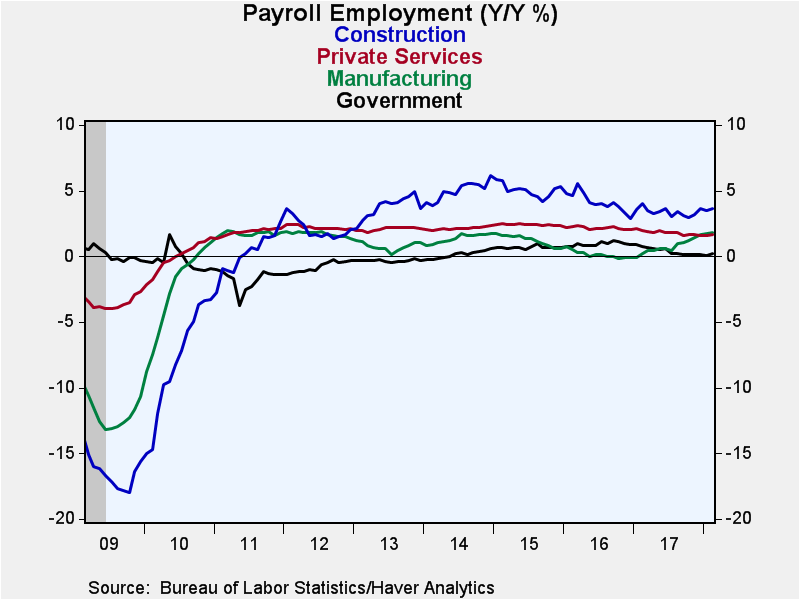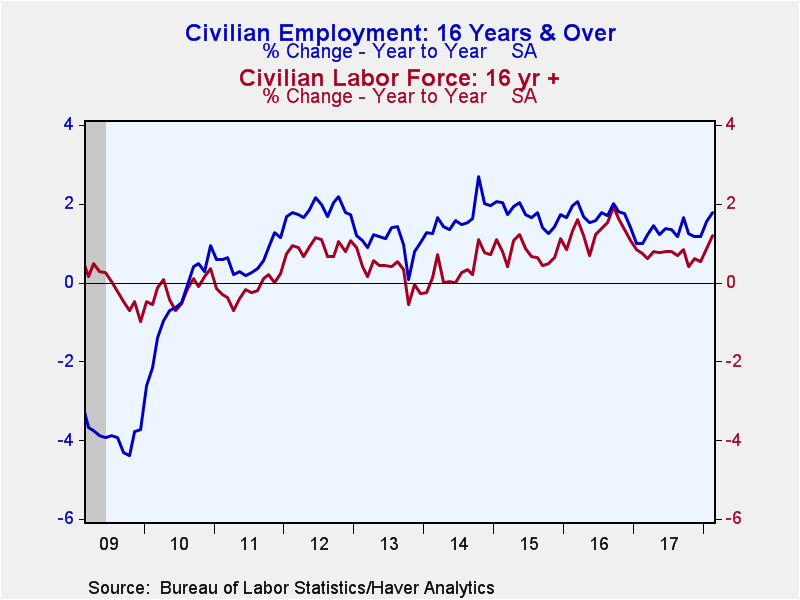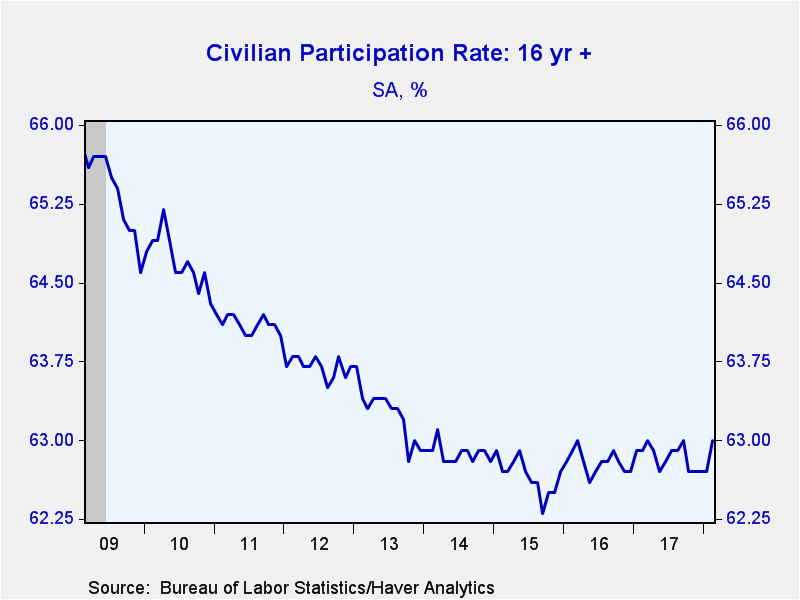 Global| Mar 09 2018
Global| Mar 09 2018U.S. Payroll Increase Strengthens; Wage Growth Eases
by:Tom Moeller
|in:Economy in Brief
Summary
The job market continues to improve. Nonfarm payrolls rose 313,000 (1.6% y/y) during February, the strongest monthly increase since July 2016. It followed a 239,000 January gain and a 175,000 December rise. Together these two figures [...]
The job market continues to improve. Nonfarm payrolls rose 313,000 (1.6% y/y) during February, the strongest monthly increase since July 2016. It followed a 239,000 January gain and a 175,000 December rise. Together these two figures were revised up by 54,000. A 202,000 increase in payrolls had been expected in the Action Economics Forecast Survey. Average hourly earnings ticked 0.1% higher (2.6% y/y) following unrevised gains of 0.3% and 0.4% in the prior two months.
The unemployment rate held steady at an expected 4.1% for a fifth straight month. The overall unemployment rate, including the marginally-attached and those working part-time for economic reasons, remained at 8.2%, down from 9.2% one year earlier.
From the payroll employment survey, the 313,000 increase in jobs reflected broad-based improvement. Construction sector jobs jumped 61,000 (3.7% y/y) following strong gains of roughly 40,000 during each of the prior three months. Factory sector employment increased 31,000 (1.8% y/y) after strength during five of the prior six months. Mining sector payrolls surged 8,600 (9.6% y/y), the strongest rise in six months.
Private service-producing employment rose 187,000 (1.6% y/y), the strongest gain in four months. The number of trade, transportation & utilities jobs surged 72,000 (0.9% y/y) as retail employment jumped 50,300 (0.2% y/y). Professional & business services employment gained 50,000 (2.4% y/y), the strongest rise since October. The rise reflected a 26,500 jump (4.2% y/y) in temporary help jobs. Health care & social assistance employment rose a steady 29,100 (1.9% y/y). Financial activities employment surged an out-sized 28,000 (1.7% y/y) after gains of roughly 8,000 during each of the prior five months; however, leisure & hospitality jobs rose a lessened 16,000 (2.0% y/y). To the downside, information sector employment declined 12,000 (-2.2% y/y) after a 16,000 fall.
Public sector employment strengthened by 26,000 (0.2% y/y), following five straight months of no growth. Local government jobs surged 31,000 (0.6% y/y) after average growth of 5,000 during the prior six months. State government employment grew 2,000 (-0.4% y/y) following a 3,000 rise, while federal government employment declined 7,000 (-0.6% y/y), the third decline in four months.
The 0.1% (2.6% y/y) uptick in average hourly earnings followed accelerated gains between 0.3% and 0.4% during the prior three months. Financial activities earnings ticked 0.1% higher (4.6% y/y) after two months of 0.7% and 0.9% increase. Professional & business services pay also inched just 0.1% higher (2.4% y/y) after thee months of 0.3% gain. Remaining strong were information sector earnings, posting a 0.8% rise (4.6% y/y) up from 0.5% to 0.7% gains in each of the prior three months. Increasing just 0.1% were earnings in trade, transportation & utilities (1.9% y/y), education & health services (0.5% y/y) and leisure & hospitality (3.0% y/y).
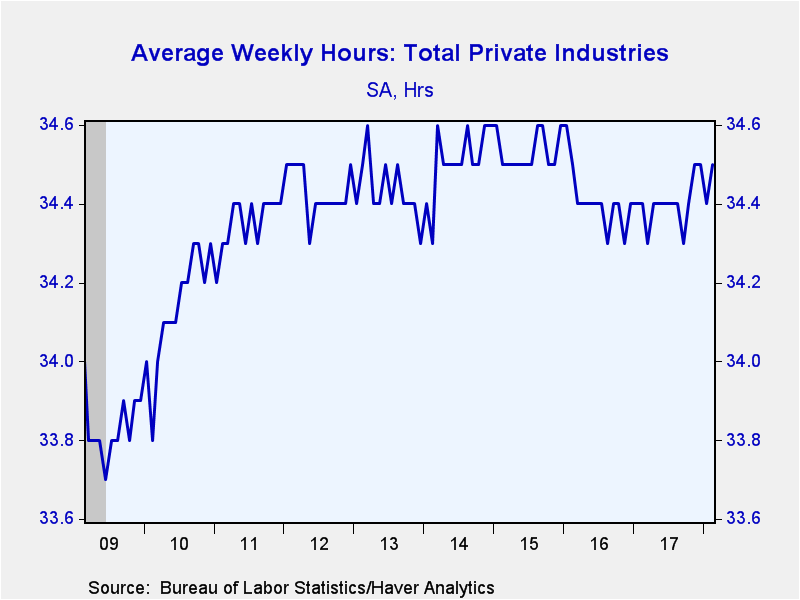 The length of the average workweek lengthened to 34.5 hours,
up from an average 34.4 hours during both 2017 and 2016. Mining & logging
sector hours lengthened to 45.9 hours from 45.2 hours last year. Factory sector
hours of 41.0 compared to roughly 40.8 hours in each of the last three years.
The construction sector workweek lengthened to 39.3 hours from an average 39.1
hours last year. Financial sector hours were stable for the last four months at
37.6. Education & health services hours jumped to 33.0, equaling the record
since 2008, and up from 32.7 in 2014.
The length of the average workweek lengthened to 34.5 hours,
up from an average 34.4 hours during both 2017 and 2016. Mining & logging
sector hours lengthened to 45.9 hours from 45.2 hours last year. Factory sector
hours of 41.0 compared to roughly 40.8 hours in each of the last three years.
The construction sector workweek lengthened to 39.3 hours from an average 39.1
hours last year. Financial sector hours were stable for the last four months at
37.6. Education & health services hours jumped to 33.0, equaling the record
since 2008, and up from 32.7 in 2014.
In the household sector survey, the stable 4.1% jobless rate reflected a 785,000 rise (1.8% y/y) in employment and an 806,000 gain (1.2% y/y) in the labor force. The labor force participation rate improved to 63.0%. The average duration of unemployment fell to 22.9 weeks, the least since May 2009.
By educational attainment, the unemployment rate for individuals without a high school diploma inched up to 5.7% while high school graduates with no college were 4.4% unemployed. Those with less than a bachelors degree realized 3.5% joblessness, and individuals with a bachelors degree or higher were 2.3% out of work.
The teenage unemployment rate of 14.4% compared to 6.8% for those aged 20-24 years. Individuals aged 25-54 years old were 3.5% unemployed, while those over age 55 were 3.2% jobless.
The labor market data are contained in Haver's USECON database. Detailed figures are in the EMPL and LABOR databases. The expectations figures are in the AS1REPNA database.
| Employment: (SA, M/M Change, 000s) | Feb | Jan | Dec | Feb Y/Y | 2017 | 2016 | 2015 |
|---|---|---|---|---|---|---|---|
| Payroll Employment | 313 | 239 | 175 | 1.6% | 1.6% | 1.8% | 2.1% |
| Previous Estimate | -- | 200 | 160 | -- | -- | -- | -- |
| Manufacturing | 31 | 25 | 39 | 1.8 | 0.7 | 0.1 | 1.2 |
| Construction | 61 | 40 | 42 | 3.7 | 2.4 | 4.1 | 5.0 |
| Private Service-Producing | 187 | 166 | 92 | 1.6 | 1.8 | 2.2 | 2.4 |
| Government | 26 | 1 | 1 | 0.2 | 0.4 | 0.9 | 0.7 |
| Average Weekly Hours - Private Sector | 34.5 | 34.4 | 34.5 | 34.4 | 34.4 | 34.4 | 34.5 |
| Private Sector Average Hourly Earnings (%) | 0.1 | 0.3 | 0.4 | 2.6 | 2.5 | 2.6 | 2.3 |
| Unemployment Rate (%) | 4.1 | 4.1 | 4.1 | 4.7 | 4.4 | 4.9 | 5.3 |
Tom Moeller
AuthorMore in Author Profile »Prior to joining Haver Analytics in 2000, Mr. Moeller worked as the Economist at Chancellor Capital Management from 1985 to 1999. There, he developed comprehensive economic forecasts and interpreted economic data for equity and fixed income portfolio managers. Also at Chancellor, Mr. Moeller worked as an equity analyst and was responsible for researching and rating companies in the economically sensitive automobile and housing industries for investment in Chancellor’s equity portfolio. Prior to joining Chancellor, Mr. Moeller was an Economist at Citibank from 1979 to 1984. He also analyzed pricing behavior in the metals industry for the Council on Wage and Price Stability in Washington, D.C. In 1999, Mr. Moeller received the award for most accurate forecast from the Forecasters' Club of New York. From 1990 to 1992 he was President of the New York Association for Business Economists. Mr. Moeller earned an M.B.A. in Finance from Fordham University, where he graduated in 1987. He holds a Bachelor of Arts in Economics from George Washington University.


